This is the second of three posts about one of the most remarkable artistic representations of the book of the Apocalypse, a series of six enormous tapestries created in Paris between 1377 and 1382. (See part one.) They were commissioned by Louis I (1339-84), the second son of King Jean II of France, and first Duke of Anjou; his grandson and third successor to his title, René, donated them to the cathedral of Angers, the capital of the duchy, in 1480. After being plundered and cut into pieces during the Revolution, the surviving parts were recovered in 1848; the third and fourth tapestries, the ones shown in this post, are basically intact. Each of them begins on the left with a man sitting under a Gothic baldachin, reading the Apocalypse from a book on a stand in front of him. There follow 14 scenes of St John’s visions arranged in the order of the book, running from left to right, first above and then below, making for 15 panels per tapestry, an original total of 90 scenes between the six. The images here are taken from this page of Wikimedia Commons, which shows the arrangement of the panels divided by tapestry (by PMR Maeyaert, CC BY-SA 4.0.)
https://commons.wikimedia.org/wiki/Apocalypse_TapestryTuesday, November 21, 2023
The Apocalypse Tapestries (Part 2)
Gregory DiPippoThe reader of the third tapestry.
The measuring of the Temple, chapter 11, 1
The two witnesses, who have power to close the heavens. (11, 3-6)
The two witnesses are slain (11, 7)...
and lie unburied (11, 8).
They rise from the dead and ascend into heaven, after which, an earthquake levels a tenth part of the city where they were killed (11, 11-13.)
The seventh trumpet; the twenty-four elders elders worship God in heaven (11, 15-18).
St john sees the temple opened up in heaven, and the vision of the woman clothed with the sun, who gives birth to a son, that a great dragon with seven heads waits to devour (11 19 - 12, 6).
St Michael and his angels make war on the dragon (12, 7-10)
The woman is given wings and escapes from the dragon (12, 13-14).
The dragon sends a great stream after the woman, which the earth swallows up (12, 15-16).
The dragon fights with those who keep the commandments of God (12, 17).
The dragon gives its power to the beast that came up from the sea, with seven heads and ten horns, and on its horns ten crowns (13, 2).
The adoration of the dragon (13, 4).
The adoration of the beast (13, 8).
The reader of the fourth tapestry.
The adoration of the beast.
The second beast makes fire fall from heaven (13, 13).
The second beast causes men to adore the image of the first one (13 14).
Men receive the mark of the beast (13, 17).
The adoration of the Lamb (14, 1).
The saved sing a new song before him (14, 2-3).
An angel flies through heaven, having the eternal Gospel (14, 6).
A second angel predicts the fall of Babylon (14, 8).
A third angel declares the punishment of those who worshipped the beast, which will take place in the sight of the angels and of the Lamb (14, 9-10).The just are given rest, and St John is told to write “Blessed are the dead, who die in the Lord. From henceforth now, saith the Spirit, that they may rest from their labours; for their works follow them.” (14, 13, the Epistle for the daily Mass of the dead.)
The harvest of the earth (14, 15-16)
The angel gathers the vines (14, 18).
The harvest of grapes (14, 19)
The seven vials of the last plagues (15, 1)






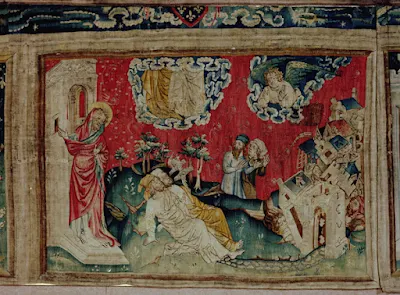
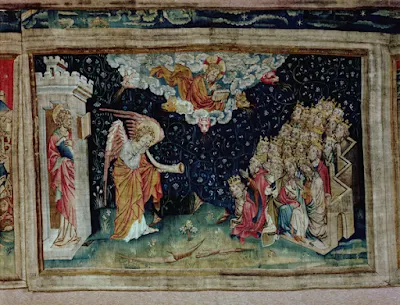



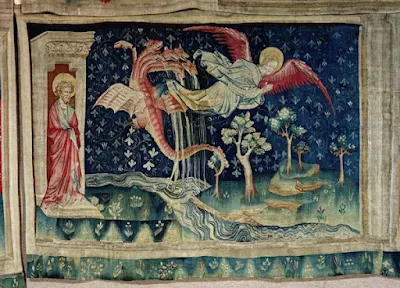

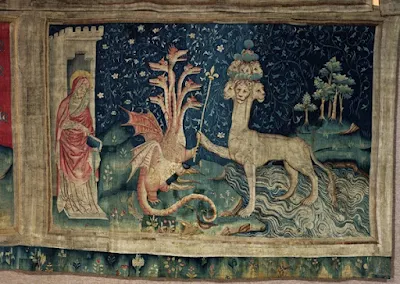


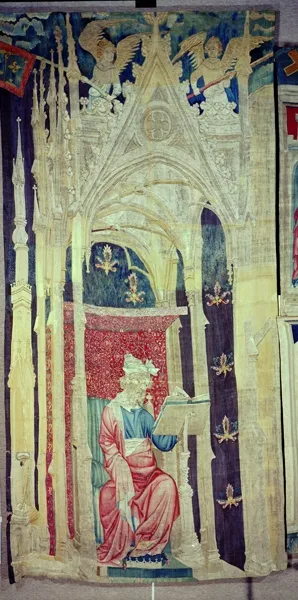



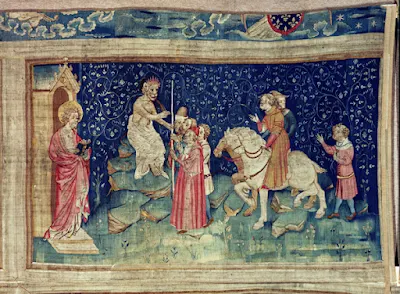









.jpg)